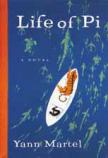Adolescent Mariner
Yann Martel won Britain’s most prestigious literary award, the Man Booker Prize, for Life of Pi, a book that reinvents the lost-at-sea novel in quite striking terms. Martel himself has been storm-tossed in a controversy about whether he inappropriately employed the premise of a 1981 story by Moacyr Scliar. In an “Author’s Note” he credits the Brazilian author for “the spark of life,” but he insists that the novel itself is an original work. And what an ingenious text it is; readers will find Martel’s novel gripping and unforgettable.
At a coffeehouse in Pondicherry, India, the author is approached by an elderly man who says, “I have a story that will make you believe in God.” He directs the author to Mr. Piscine Molitor Patel (Pi for short) in Toronto, who narrates most of the novel. The grown Pi takes us back to a time when he was 16 years of age (Pi is the 16th letter in the Greek alphabet), growing up in an eccentric and loving family, presided over by his father, who gave up a career as hotelier to become a zookeeper. Pi notes, “My alarm clock during childhood was a pride of lions.”
The boy owes his name to a fabled swimming pool in Paris, and although his peers nickname him “Pissing,” the connotation of fish-like adaptability is a consoling prognostication of the piscine skills he will need later during 227 days adrift at sea. His name also has a mathematical connotation as the never-quite-finished calculation of the relationship of a circle’s circumference to its diameter, which is suggestive of the relationship between linear journey and cyclical pattern. On one level, Pi’s narrative concerns a voyage from India to the coast of Mexico, but it is also caught up in the diurnal cyclical patterns of life at sea, and the cycle of doubt and faith.
The youthful Pi has a strong penchant for religious faith. Initially steeped in Hinduism, he encounters Christianity at age 14 and asks to be baptized. Subsequently he also embraces Islam. He intends to follow all three faiths simultaneously, but the strategy backfires when a priest, imam and holy man happen to meet him and his parents all at the same time.
Pi offers fresh and moving descriptions of these great faiths: “If Hinduism flows placidly like the Ganges, then Christianity bustles like Toronto at rush hour. It is a religion as swift as a swallow, as urgent as an ambulance.” Islam is “a beautiful religion of brotherhood and devotion.” Since according to Pi, “the presence of God is the finest of rewards,” his triple religious affiliation provides him three ways to experience that consoling presence. At various dire moments, he is thus able to offer a compound ecumenical prayer-salutation: “Jesus, Mary, Muhammad and Vishnu!”
The decision of Pi’s family to move to Canada, taking with them a number of the zoo’s animals, sets the stage for the novel’s crisis, the sinking of their ship at sea. Pi is set adrift in a lifeboat with a Bengal tiger named Richard Parker. The reader’s first impulse is to want Richard Parker to possess Disneyesque charm and geniality, but Martel makes a compelling case that the threats of sea and tiger can be present in the same confined space with the boy. The lifeboat serves as a simultaneously claustrophobic and expansive setting, a stage that is by turns a circus ring, a killing field and a place of prayer.
When dubious government investigators later question Pi’s account of his horrific ordeals at sea, he retorts: “Tigers exist, lifeboats exist, oceans exist. Because the three have never come together in your narrow, limited experience, you refuse to believe that they might.” The investigators lack Pi’s openness, and he admonishes them: “You want a story that won’t surprise you, that will conform to what you already know, that won’t make you see higher or further or differently. You want a flat story. An immobile story. You want dry, yeastless factuality.” Life of Pi is anything but yeastless. A surprise twist at the end of the novel offers an entirely different interpretation of Pi’s story. What really happened in the lifeboat, and what stories can we tolerate as possibly true?
Martel takes his place among such literary figures as Hopkins, Shelley and Byron, who have treated shipwrecks as paradigmatic crises in human meaning. One who is set adrift finds himself or herself exposed to the worst (and occasionally to the best) of nature and human nature. Consider Stephen Crane’s story “The Open Boat,” in which the situation of being adrift confronts one with what Crane, himself the survivor of a shipwreck, called “the unconcern of the universe.” Survivors of shipwrecks become interpreters of man’s everyday condition and ultimate fate. Like the Ancient Mariner, the adolescent mariner Pi has an important tale to tell.
Martel’s novel is extremely well written, reflective when it needs to be reflective, thrilling when it needs to convey adventure on the high seas and ultimately more than engrossing in its generous blend of zoology and theology. It has moved the imaginations of such a large readership that the tourism director of Pondicherry, India, is currently promoting the idea of building a zoo to correspond with early scenes in the novel.
For the rest of us, the point is not whether there is a zoo in Pondicherry, but rather whether this is, indeed, a story to strengthen one’s faith. There are two distinct and quite different ways to understand the novel’s conclusion. Martel offers the choice of interpretation as a gift to the reader.
This article also appeared in print, under the headline “Adolescent Mariner,” in the April 14, 2003, issue.








